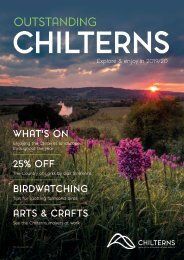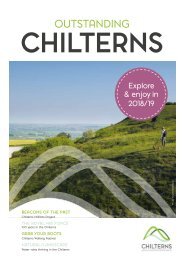Outstanding Chilterns Magazine 2022/23
Enjoy & explore the beautiful Chilterns landscape 2022/23
Enjoy & explore the beautiful Chilterns landscape 2022/23
- No tags were found...
You also want an ePaper? Increase the reach of your titles
YUMPU automatically turns print PDFs into web optimized ePapers that Google loves.
Young explorers
CHILTERNS
YOUNG EXPLORERS
RED KITES & BUZZARDS: SPOT THE DIFFERENCE
Red kites and buzzards can be hard to tell apart when they’re flying high. Both birds like to glide in
circles – they’re catching a ride on the thermals (columns of warm air which help the birds rise higher).
FOCUS ON:
fabulous wild flowers
Did you know there are over 50 native species of
orchids in Britain? We’re lucky in the Chilterns that
our chalk grassland is home to several species –
they’re not the same as the ones you see in pots in
peoples’ houses but ones that grow wild in the open
air. The Chilterns is also one of the few places you
can find the rare Chiltern gentian, Pasqueflower and
red Helleborine.
There are many nature reserves where you can spot these
distinctive wild flowers, please visit the websites of the
organisations below to find out where to see them:
Chiltern Society: www.chilternsociety.org.uk
Berks, Bucks and Oxon Wildlife Trust: www.bbowt.org.uk
Herts and Middlesex Wildlife Trust: www.
hertswildlifetrust.org.uk
Bedfordshire, Cambridgeshire and Northants Wildlife
Trust: www.wildlifebcn.org
National Trust: www.nationaltrust.org.uk
Did you know:
Orchids have been around for a really long time
– they are thought to date from 76 to 84 million
years ago.
British species of orchid vary from common
and widespread to extremely rare, like the Red
Helleborine.
Some orchids are pollinated by insects, others
pollinate themselves or reproduce via plantlets or
offshoots (a bit like strawberries)
Orchids need to be infected with a particular
fungus to grow, otherwise they can’t obtain the
right nutrients.
Chalk grasslands can support up to 40 species of
wildflowers per square metre.
Having lots of different types of flowers is really
good for butterflies, as it provides them with a
source of food – like the rare Duke of Burgundy
and more common butterflies such as the Chalk
Hill Blue and Brown Argus.
Why not ask your parents if you can leave a patch
of your lawn unmown for a while and see what
pops up?
A cut-out-and-keep guide to some
of our special Chilterns wild flowers
Last year’s butterfly guide was so popular that we’ve
made another one to help you spot some of our beautiful
wild flowers this summer. Please remember that orchids
and other flowers are protected by law so don’t pick
them, and do follow the countryside code when visiting
the Chilterns or other natural areas.
CHILTERN GENTIAN
LOOK FOR: Five-petalled, trumpet-shaped
flowers
WHERE: One of the UK’s rarest wild flowers
and it is only found at a few sites, mostly in
the Chiltern Hills.
WHEN: Late summer
BEE ORCHID
LOOK FOR: Pink petals with what looks
like a bumble bee sitting on them.
WHERE: chalk grassland, particularly if
disturbed, so can be seen in former quarries,
railway embankments and even lawns!
WHEN: June/July
PYRAMIDAL ORCHID
LOOK FOR: Distinctive pyramid shape
with bright pink flowers
WHERE: Chalk grasslands but also
sometimes in manmade environments
such as by the side of motorways!
WHEN: June/July
COMMON SPOTTED ORCHID
LOOK FOR: Tall pink spikes with deeper
pink/purple spots. Leaves have dark spots.
WHERE: Common in chalk grasslands
WHEN: June-August
WHITE HELLEBORINE
LOOK FOR: Up to 16 white flowers on a stem
that can reach 60cm, these grow on their
own or in small groups.
WHERE: woodlands, especially beech
woodlands with underlying chalk soils, also
more open areas.
WHEN:Early May until the end of June
PASQUE FLOWER
LOOK FOR: Purple five-point star with a
yellow centre, considered “vulnerable” in
the UK.
WHERE: Chalk and limestone grasslands,
especially in the northern Chilterns.
WHEN: Flowers at Easter time which gives
it its name.
RED KITE
Has longer ‘fingers’
on its wing tips.
Holds its wings
fairly flat when
it flies
Intense reddishorange-brown.
Wingspan: 1.8
metres - as tall
as some adults!
In April 2022 Chalk Cherries and Chairs
ran our first ever Chilterns Landscapes Art
Exhibition at Wycombe Museum, featuring
local artists. Pupils in years 1 to 6 were
invited to send their art into our Schools’
Art Competition, showing what the
Chilterns means to them.
Our Education Consultant visited local
schools, helping them to explore how the
Chilterns was special and different in the
past, where people lived and worked, and
what kind of things people did and made.
We were delighted to receive 250 schools’
entries! 30 were selected for the exhibition.
Here are the winners – can you spot a
picture by someone at your school?
Young Artists
in the Chilterns
KS1 WINNER
Spencer,
age 5
KS2 WINNER Pippa, year 3 KS2 WINNER Sawera, year 5
Under 18s, send your pictures, photos and writing about Chilterns
landscapes or wildlife to vpearce@chilternsaonb.org – you could
be featured in next year’s magazine or our social media!
BUZZARD
bee orchid
bluebell
bramble
chiltern gentian
Where to spot buzzards
& kites: both birds sometimes
like to perch on telegraph poles,
fence posts and the top of trees.
Wildflower Word Search
cowslip
foxglove
ivy
Word Search Answers
26 27
A forked tail
Has shorter ‘fingers’
on its wing tips.
Holds its wings
in a v shape
when it flies
Vary in colour from pale
to dark brown & can
sometimes look very
white underneath.
Wingspan:
around 120 cm
– as tall as an
average 7 year
old!
A fanned tail
Buzzard
Red Kite
Listen to their calls: and
get to know other bird calls on
www.xeno-canto.org
oxeye daisy
snowdrop
wild garlic






